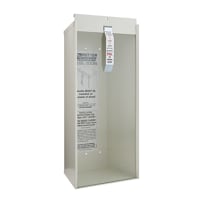Experts Recommend Fire Extinguishers for Homes and Businesses
Results from a nationwide research study show that only one in three (34%) American households have more than one fire extinguisher while nearly four out of five (78%) have more than one television. Having a fire extinguisher within reach can help you create a path to safety, and may even help put out a small, contained fire. Be safer in your home by learning more about fire extinguishers. Place a fire extinguisher within easy reach in rooms where fires are more likely to start such as the kitchen, living room and laundry room.
Choosing a Fire Extinguisher for Your Home
Below are minimum recommendations for the home from the National Fire Protection Association (NFPA).
Step 1
Choose primary extinguishers for your home. These include solutions for your living area and garage or workshop, and they’re pieces of equipment that you absolutely must have, according to the NFPA.
-
Living area – For your main home protection, install a 2-A: 10-B:C rated living area unit on every level of your home. No more than 40 feet apart. Class A-B-C
-
Garage/Workshop – Due to volumes of flammable liquids in the garage, you should install a higher rated unit such as the 3-A:40:B-C Garage/Workshop unit. Class A-B-C
Step 2:
Choose supplementary extinguishers for your kitchen and areas with a higher likelihood of electrical equipment fires. These are not required but are highly recommended.
-
Kitchen – The kitchen is the likeliest place you will have a fire. Protect your home with a 711A extinguisher in the kitchen area.
-
Electrical – Ideal for tackling fires involving energized electrical equipment with a rating of 1-A: 10-B:C. Class B-C
Find several types of Kidde fire extinguishers for your home in our product catalog: including ABC fire extinguishers (Class ABC dry chemical) or an electrical fire extinguisher (Class BC dry chemical).
Choosing a Fire Extinguisher for Your Business
Below are the minimum business recommendations from the National Fire Protection Association Standard for Portable Fire Extinguishers (NFPA 10). Many cities and states require fire extinguishers with a minimum UL rating of 2-A:10-B:C in buildings. Check with your local fire authorities for the building code requirements in your area.
Low Hazards (PRO 210)
-
A 2-A: 10-B:C rated rechargeable unit.
-
For offices, churches, assembly halls, classrooms and hotel guest areas.
-
Class A-B-C
Medium Hazards (PRO 340)
-
A 3-A:40-B:C rated rechargeable unit.
-
For light manufacturing facilities, dining areas, auto showrooms, parking garages and storage areas.
-
Class A-B-C
High Hazards (PRO 460)
-
A 4-A:60-B:C rated rechargeable unit.
-
For manufacturing facilities with processes involving flammable liquids, boat and vehicle services, and woodworking processes.
-
Class A-B-C
Browse Kidde fire extinguishers for commercial and industrial use, or learn about types of fire suppression systems that may be used for your business.









